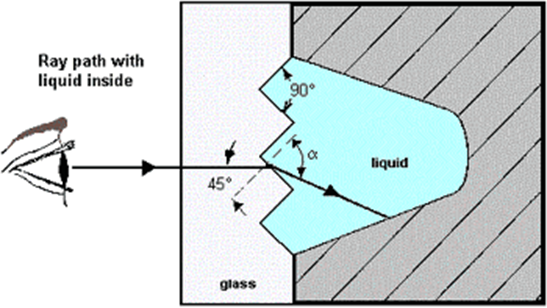.reflex
Article link: http://www.altonashop.com/Products/reflex_glass_level_gauges.htm
Working principle:
Reflex level gauges working principle is based on the light refraction and reflection laws.

Reflex level gauges use glasses having the face fitted towards the chamber shaped to have prismatic grooves with section angle of 90°. When in operation, the chamber is filled with liquid in the lower zone and gases or vapors in the upper zone; the liquid level is distinguished by different brightness of the glass in the liquid and in the gas/vapor zone. The reflex level gauges do not need a specific illumination: the day environmental light is enough. Only during the night an artificial light must be provided.
The different brightness in the two zones is obtained as explained below:
Liquid Zone:
This zone appears quite dark when the gauge is in operation and lighted as above said.

Given the construction, most of the environmental light rays incident on the external face of the glass are quite perpendicular to said face and, therefore, not deviated by the glass. These rays reach the glass/liquid interface with an inclination of approx. 45°. The critical angle glass/liquid is always superior to 45°. Therefore, the ray’s incident within the critical angle (practically the totality) are refracted within the liquid and, since the internal walls of the gauge chamber are not reflecting, the rays cannot be seen from the outside. In fact, the zone will appear dark, nearly black, to the observer.
Gas/vapor Zone:

This zone appears almost silver bright to the observer. As for the liquid zone, the light rays reach the glass/gas-vapor interface with an angle around 45°. Since this angle is greater than glass/gas-vapor critical angle, the rays are not refracted, but totally reflected making 90° turn, thus reaching the nearest glass/gas-vapor interface again with angle of 45°. For same reason they will be reflected and turned by 90° towards the observer, to whom the zone will
